Preserving Nature and Culture at Morro Rock
A research paper by Angela
Howard Dillon angela1224@[remove]earthlink.net
For Woodbury University – Burbank, CA
– Revised
Monday, February 18, 2008 10:53:51 PM
On February 7, 2002, an
article entitled “Messy Affair Plays Out Atop Famed Rock” ran in the Los
Angeles Times’ Living Section. Next
to it was an aerial shot of Morro Rock in Morro Bay. Rising out of the ocean next to the rolling breakers in the
outer bay and miles of rugged, picturesque shoreline extending as far as the eye
can see, Morro Rock is truly a spectacular sight.
No matter how many other spectacular landscapes I may see in my lifetime, none will surpass this one, because it holds such special significance for me. It is where nearly every family vacation in my childhood was spent, and where my son and I have spent every 4th of July weekend since he was four.
Over the 30-plus years
I’ve been coming here, I’ve watched Morro Bay evolve from a quiet fishing
village into a popular tourist destination.
I remember the town before there were sidewalks on the Embarcadero,
before the motels outnumbered the private residences and before new housing
developments and shopping centers dotted the landscape.
And I remember the last trip I took there with my mother and father in
August 1977. Mom had just been
diagnosed with a brain tumor, and she wanted to see her favorite place once more
in case it turned out to be the last time, which fortunately, it didn’t.
As I read the article, I
found out that my special ownership of this place had competition.
Apparently, a few hundred years before I laid claim to Morro Rock’s
historical significance to my family, a group of Indians and a predatory bird
beat me to it. Furthermore, it
seems there is an ongoing controversy as to whose needs are paramount – those
of the bird to exist without interruption, or those of a Native American to
reclaim his lost heritage.
For centuries, Morro Rock
has been a nesting site for the peregrine falcon and, according to Salinan
Indian legend, Morro Rock is where hawk and raven destroyed the serpent-monster
Taliyekatapelta (Brusa, 55). Salinan
descendent John Burch claims that, when he was a boy, his grandmothers took him
to the top of Morro Rock to carry out ancient religious rituals of their tribe.
Now, many years later, he wanted to once again climb the rock to repeat
those ancient rituals. Since being
declared State Historical Landmark No. 821 in February 1968, Morro Rock has been
off limits to climbers, but in 1999 Burch received a special permit from the
Department of Fish and Game, giving him permission to do so on certain specific
dates for religious purposes. He
made a couple climbs without incident, until being spotted by local peregrine
watchers during one descent. They,
along with members of the San Luis Obispo Chumash Tribe, brought political
pressure to have Burch’s permit revoked, citing the need to protect the
peregrines (Ferrell, B2). What had
initially sounded like a nostalgic tribute to one Native American’s heritage
had become far more complicated than that.
There was apparently much more to this story than space in the short
newspaper column allowed. What was
the story behind the serpent legend? What
were the ancient rituals the Salinan practiced on Morro Rock?
And why, if they and the peregrines had apparently co-existed for
centuries without a problem, could they not do so now?
My search for information
began on the Internet, where I located a web page devoted to the history of the
peregrine at Morro Rock that included a link to an e-mail group dedicated to
discussions about the Morro Rock peregrines.
I joined the group and posted a message saying that I was planning a trip
to Morro Bay to do research for a paper I was writing on the peregrines and the
John Burch issue, and asked if anyone could point me in the direction of
information regarding either. I
received in reply an invitation to watch the peregrines at Morro Rock, and to
attend a class about them at San Luis Obispo’s Cuesta College.
On my way up Highway 101, I
stopped at Pismo State Park and asked a docent at the nature center if she knew
where I might find information about the Salinan Indians.
She suggested I visit the mission in San Antonio Valley, which had once
been living quarters for many of the Salinan.
Highway 41 through Atascadero led me to Jolon Road near Bradley, where I
turned off and drove until I reached the mission, on the grounds of Hunter-Liggett
military base, just inside the Monterey county line.
It stood against the hills in the middle of the lush, oak woodland that
comprises the San Antonio Valley. Inside
a book in the mission’s gift shop, I found the story of the Salinan legend of
Taliyekatapelta. Although I have
since located two additional versions of the story, each slightly different,
this one is the most complete: Hawk
(or falcon, depending on the version you favor) and Raven decided to seek out
and destroy a terrible two-headed snake called Taliyekatapelta. They found the serpent somewhere east of Morro Bay, but it
began chasing them. Hawk and Raven
flew to Morro Rock, where Raven’s powers came from, but the snake came swiftly
after them and, with its huge body, encircled Morro Rock and began to wind its
way upward. As Taliyekatapelta
approached, Hawk and Raven took out their knives and began to hack away at it,
until it fell into pieces (Brusa, 55). As
I left the mission and headed back towards Morro Bay, I thought about the irony
of my discovering an Indian legend in the very place where Salinan heritage had
all but been destroyed. Nonetheless
elated with my find, I drove back toward San Luis Obispo, where the following
morning I would attend Steve Schubert’s class on Morro Rock’s peregrine
falcons.
Steve Schubert holds an MS
in biology from Cal Poly and in the 1970s he was a peregrine falcon nest guard
in the Santa Lucia Mountains. The
first half of his class consisted of a very informative lecture and spectacular
slide show (he had close-ups of the falcons in mid-flight). Notes from this lecture helped me to understand why the local
residents had such a concern for the well-being of this regal bird.
Diurnal birds of prey, the peregrines are part of the raptor family,
characterized by a hooked beak, sharp talons and excellent eyesight.
They have narrow, pointed wings, a long, narrow tail and are built for
speed, with the amazing ability to attack at speeds of up to 200 miles per hour.
Shortly, I was to see firsthand how captivating they are to watch in
flight. Peregrines prefer to nest
on vertical faces of cliffs near a body of water, making Morro Rock an ideal
spot. As far as anyone can
remember, only one pair of falcons has nested at Morro Rock but as of last year,
two pairs have taken up residence, a rare occurrence.
The newcomers, who currently occupy the north side of Morro Rock, have
been named Zephyr and Xena by the locals. The
south side peregrines are Rudy and Judy; Rudy has enjoyed several seasons at
Morro Rock, but Judy is a fairly new arrival.
Rudy’s prior mate, Millie, did not return this year and it is believed
that she died. The peregrine will
mate for life, but will readily replace a mate that has died.
“Floaters” live alone until a “vacancy” comes up, and it is this
floating population that has helped the peregrine survive.
During March, female
peregrines lay three to four eggs on a flat ledge or in a pothole.
The female and male peregrines take turns incubating the nest, but once
the eggs hatch, the male flies off to hunt for food.
Returning with the prey, he gives a food exchange call to alert the
female of his arrival. The female
leaves the nest and flies out to meet him.
She then flips upside down, takes the prey from the male and carries it
back to the nest. During nesting
season the peregrines become extremely aggressive towards any intruders, and
have been known to “thump” gulls that get too close.
They will attack people, vultures, condors, anything that comes too close
to the nesting site, known as the eyre. From
this description, it did not seem to me that the peregrines had much to fear
from John Burch, but rather it was he who might need protecting from them.
What has made local
citizens so protective toward the Morro Rock peregrines has been due to a series
of tragedies, one of which nearly caused the bird’s extinction.
DDT, which remains in the soil for decades, was used extensively in the
Salinas Valley during the 1960s. Insects
ate the soil, birds ate the insects, and the peregrines ate the birds.
Passing through the food chain, the DDT caused the eggs laid by the
female peregrine to have abnormally thin shells that broke when the parents
tried to incubate them.
The Morro Rock peregrines
have faced several other threats as well, including feral cats and poachers.
Since the early 1967, there has been a volunteer monitoring program
(Wieman, 55). Once, after a male peregrine was shot, a volunteer named
Merlin took up residence atop Morro Rock for the duration of the nesting season.
Learning to imitate the male peregrine’s food exchange call, he would
drop food for the hatchlings to the female peregrine when she flew out of the
eyrie.
During the 1970s, the
Peregrine Fund was established at Cornell University in New York and a
captive-breeding program was initiated. Cornell
staff traveled to Morro Rock and removed peregrine eggs from their nests,
replacing them with “dummy” eggs made of plastic or wood.
Sometimes the nests would be left empty in the hopes that a “double
clutch” would result (the laying of another set of eggs in one breeding
season). When it was time for the
eggs to hatch, volunteers replaced the dummy eggs with either prairie falcon or
red-tailed hawk hatchlings. The
peregrine hatchlings were too scarce to take chances with.
Only if the peregrines accepted the babies and began to nurture them were
these “foster” chicks then replaced with the original peregrine hatchlings.
In 1999, with over 175 active nests in California, the peregrine was
finally removed from the Endangered Species.
Captive breeding is no longer conducted at Morro Rock, but chicks
continue to be banded, prey remains are removed for identification and empty
eggshells are removed to test for DDT thinning by the Santa
Cruz Predatory Bird Research Group at UC Santa Cruz.
To conclude our class, we
drove out to Morro Rock, hoping to spot at least one peregrine.
We were not disappointed. There
was the female, perched just below the heart-shaped rock at the summit of the
south slope. Several local peregrine watchers were in attendance, with an
array of expensive telescopes. The
male appeared, and we had the rare opportunity to witness their mating ritual.
Afterward, he put on quite an impressive show for us, gliding out over
the bay and then contracting his wings to plummet towards the waterline.
Talking later with some of the peregrine volunteers, I learned their
concern with the Burch issue was not over just one man being allowed to climb
the rock, but fear that it might open the door to a parade of climbers. After all, if one person could obtain a permit to climb for
religious purposes, how could others who might make similar claims be turned
away? I sympathized with their
reasoning, yet I wanted to know more of the Salinan side of the story.
Like the peregrine, the
Salinan Indians had nearly faced extinction following European contact.
These indigenous people of southern Monterey and northern San Luis Obispo
counties have a history in the area that stretches back over 10,000 years, and
may be the oldest population in this area of California.
Sadly, their heritage was decimated by the entry of Europeans who founded
five missions on the lands of the Chumash and three on the lands of the
Salinans. Today, the Salinan Nation descendants number just over 700
(Alger, 1).
John Burch has a sister,
Patti, who is a well-respected docent at the Morro Bay Natural History Museum.
After the peregrine class, my next stop was the museum and, while there,
I was fortunate enough to speak with Patti by phone.
When I asked her about the Salinan’s history with Morro Rock, she
stated (as did the legend of Taliyekatapelta) that it was believed to be the
place from which the falcon derived his power, and that it was also believed to
be a place of power for the Salinans. On
the summer solstice, when the sun was at its furthest point north, the
Salinans climbed Morro Rock to pray for the sun to return.
They feared that, without their prayers, the sun would disappear in the
distance and might never return. They
also prayed for safe passage to the next world for loved ones that had passed
on. Patti mentioned that the rocks
(referring to the series of nine volcanic plugs that stretch from San Luis
Obispo into the Pacific) were “magnetic” but was “not sure if that plays
into anything.” When Patti’s
mother was a girl, Morro Rock was completely surrounded by water. Kids used to take rowboats out to the rock but they were
unable to land because of hundreds of little black rattlesnakes that inhabited
it. The Salinans believed that all
rattlesnakes originated from those on Morro Rock. Perhaps this is where the story of the serpent originated –
the early native Indians might have believed that the many small rattlesnakes
emerged as a result of the serpent being cut up into pieces.
Patti claimed that John had been climbing Morro Rock since he was a
teenager, and had hoped to continue to do so “legally” by obtaining the
permit. Her words were sincere, and
I felt sympathy and a sense of regret at what seemed an impossible situation.
Yet why now, at this
particular point in time, was it suddenly so important for John Burch to be able
to climb Morro Rock in order to practice long forgotten rituals of his tribe?
Coincidentally, it seems Burch showed up at the Rock right around the
time that Duke Energy announced they would be tearing down the old PG&E
power plant adjacent to Morro Rock and building a new one.
By law, the excavation for such a project would require members of an
Indian tribe to oversee the work in the event that Indian artifacts or burial
grounds are uncovered. Since the
Chumash were believed to have been the exclusive inhabitants of this area, it
was assumed that the work would go to members of their tribe. But now John Burch had arrived on the scene, claiming Morro
Rock to be of great religious significance to him due to his ancestry and,
because of the timing, both the local Chumash leaders and peregrine volunteers
questioned his motivation. Speculation
was made that Burch had applied with Duke Energy for the position of monitoring
their construction project. Perhaps
he did, but an article in the local Sun Bulletin dated November 8, 2000, stated
that the SLO County Chumash Council and Duke Energy had signed an agreement
allowing Chumash observers to oversee the new power plant construction.
Time may bear out Burch’s sincerity.
Since the opportunity for financial gain in the Duke matter has been
decided, if Burch continues his quest for a permit to climb Morro Rock, I would
be more inclined to believe that his intention was sincere.
As science and technology
have become the practical gods of the modern age, what place do ancient rituals
atop a 20-million-year-old volcanic plug have in 21st century society?
Perhaps Salinan descendant Joe Freeman best summarizes the answer by
writing, “There are those who say that we must live in the world today and
forget the past. Some, however, suggest that understanding the past enables us
to live more completely in the present and prepares us for the future.
They say that important cultural knowledge is imbedded in the heart of
our stories. This knowledge teaches
us how to be People. It is available and meaningful from one generation to the
next, if we stop and listen. Some
say that one needs to listen to the stories over and over again, to sit in quiet
places and to pay attention to the dreams before meaning begins to emerge.
Ultimately, each individual must do their own thinking” (7).
Scientific advancement
nearly extinguished the peregrine falcon, yet massive recovery efforts that
sought to restore its number have been quite successful.
Efforts to restore Native American heritage have not been as diligent.
How could we have eagerly rushed in to help undo the harm we enacted upon
one species, yet been so indifferent to the damage done to one of our own?
Since the late 1970s there
has been a gradual movement among California Natives to rebuild and celebrate
their cultural heritages. In dense
groves of ancient sequoias, in lush valleys and forbidding deserts, and atop
sacred peaks such as Morro Rock, California Indians have revived age-old
ceremonies, hoping to return balance to their lives and to their relationship
with the land (Krol, 1). Whether
or not John Burch is sincere in his motives does not change the fact that he is
reviving cultural knowledge for the Salinans. Yet many tribes have adapted their ancient rituals so as not
to conflict with current environmental issues.
The Chumash, who also claim their ancestors practiced tribal rituals atop
Morro Rock, now say they are content to recreate these ceremonies at the base of
the Rock (Ferrell, B2). And,
despite their treaty right, Makah Indians, whose whale hunts date back
archaeologically at least 2000 years, abandoned their hunts for nearly 30 years
after commercial whaling operations severely depleted North Pacific whale
populations (Perry, 2).
On the last night of my
visit, I drove out to Morro Rock. From
a distance, it was impossible to see in the darkness but, as I approached, the
giant monolith’s black silhouette emerged against the night sky.
There was nothing but the sound of powerful wind and waves, with
countless stars overhead. I thought
about John Burch and his grandmothers, and about my own family’s connection to
this place. Somewhere overhead, no
doubt, the peregrines were nestled in their eyrie, completely oblivious to their
own historical claim to this place and the controversy that has erupted as a
result.
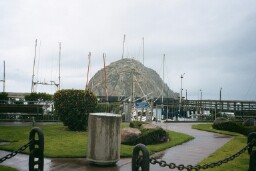
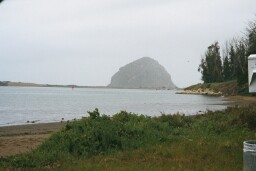
Morro Rock
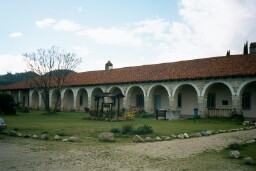
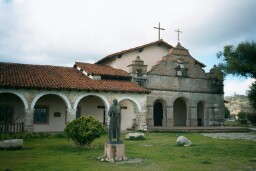
Mission San Antonio – San Antonio Valley, CA
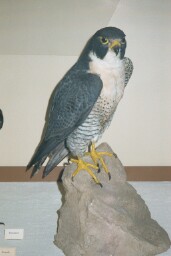 Peregrine Falcon
Peregrine Falcon
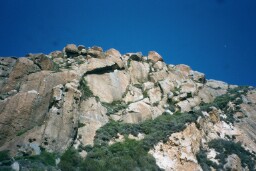
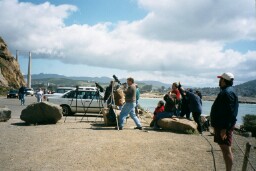
Morro Rock Summit Peregrine Watchers at Morro Rock
For discussion and news exchange of Peregrine Falcons and other bird of prey throughout the world, please visit http://groups.yahoo.com/group/peregrinefalcon/. “The Morro Rock, Morro Bay, CA Peregrine Falcons are of particular interest here.”
“An excursion up Morro Rock May 14, 2001, for banding Peregrine Falcon chicks” is detailed at http://morro-bay.com/outdoor/morro-rock/5-14-01-climb/SCPBRG.htm.
Works Cited
Alger, Doug. Press Release. Salinan National Tribal Council. 11 Apr., 2000.
Brusa, Betty War. Salinan Indians of California and their Neighbors. Happy Camp, CA: Naturegraph, 1975.
"Patti," Telephone Interview: Morro Bay, 16 Mar. 2002.
Farrell, Neil. “Duke, Chumash sigh pact on plant project.” The Sun Bulletin 8 Nov., 2000, A10.
Ferrell, David. “Messy Affair Plays Out Atop Famed Rock.” Los Angeles Times 7 Feb. 2002, California ed.: B2.
Freeman, Joe. “Salinan Elders of the Land.” Pelicannetwork. 2001. Salinan Tribal Council. 2 Feb. 2002 http://www.pelicannetwork.net/salinan.eldersoftheland.htm.
“History of Morro Bay.” Morro Bay Online. 1997. Morro Bay Chamber of Commerce. 24 Feb. 2002. http://www.morrobay.com/History/index.asp.
“History of Morro Rock and the Nine Sisters.” Morro Bay Online. 1995. Morro Bay Chamber of Commerce. 11 Feb. 2002. http://www.morrobay.com/rock.htm.
Krol, Debra Utacia. “California Indians: out of the shadows to reclaim lost heritage.” Native Peoples Sept./Oct. 2001: 12. OCLC FirstSearch. Wilson SelectPlus. Woodbury University Library, Burbank. 27 Feb. 2002 http://firstsearch.oclc.org/.
Mason, J. Alden. “The Language of the Salinan Indians.” UC Berkeley Publications in American Archaeology and Ethnography 14 (1918): 1-154.
Perry, Paul. “The History of the Makah Whale Hunt.” Alamut. 1999. 27 Feb., 2002 http://www.alamut.com/subj/the_other/misc/makahWhaling.html.
Schubert, Steve. “Los Angeles Times article.” E-mail s_schub@[remove]webtv.net or Peregrinefalcon@[remove]yahoogroups.com. 9 Feb. 2002.
Schubert, Steve. Lecture: “The Peregrine Falcons of Morro Rock.” Cuesta College, San Luis Obispo, 16 Mar., 2002.
Sullivan, Joan. “MB Natural History Museum Docents Trained in Chumash and Salinan Cultures.” Beach Gazette 13 Sept. 2000, B3.
Sullivan, Judy. “John Burch (Los Angeles Times article).” E-mail to allthatrazz@[remove]earthlink.net or peregrinefalcon@[remove]yahoogroups.com 10 Feb. 2002.
Sullivan, Judy. “The Peregrine Falcons of Morro Rock.” Santa Cruz Predatory Bird Research Group. 24 Feb. 2002. http://www.angelfire.com/ca2/peregrinefalcon/index.html.
Wieman, Harold. Morro Bay Meanderings. San Luis Obispo: Padre Productions, 1984.